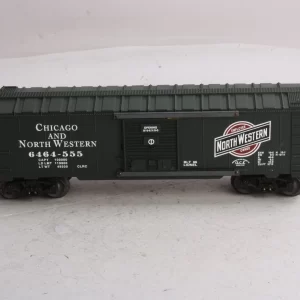DESCRIPTION:
Pennsylvania Railroad PRR GG-1 Electric Locomotive DCC/Sound Road Number 4935 in HO Scale made by Trix. MSPR for this item is $545. Item #22810
Prototype: Pennsylvania Railroad (PRR) type GG-1 heavy general purpose locomotive. 4-6-6-4 wheel arrangement. Built by General Electric and Westinghouse starting in 1934. Originally in standard Brunswick Green design with 5 decorative stripes. Use: Freight trains and passenger trains on main lines of the PRR, later Penn Central, Conrail and Amtrak.
Model: Era II and III, die-cast metal chassis and superstructure. Digital decoder based on DCC standard with sound generator. High-efficiency motor with centrally installed bell-shaped armature. 4 powered axles in each draw frame. 4 traction tires. Articulated frame to enable unit to negotiate sharp curves with 2 sets of powered wheels and 2 sets of carrying wheels. Headlights will work in conventional operation, can be digitally controlled. Headlights, engineer’s cab lights 1 and 2, acceleration and braking delay and several operating sounds (fans, continuous bell, single whistle signal, sequence whistle signal and blowing off air, switching mechanism, main switch and brakes) can be controlled digitally with Trix Systems or DCC. High-performance speaker. Large American design antograph. Separately applied metal grab irons. Wheel sets based on American standard RP 25. Couplers are compatible with Kadee system. Length over couplers 280 mm / 11-1/32″.
Loewys Crocodile In the 1930s, in the middle of the deepest depression, the Pennsylvania Railroad (PRR) ventured to electrify their main routes in the eastern United States. This gigantic project included the repair and reinforcement of tracks, the construction of new tunnels with larger diameters, as well as the integration of suburban railroads. The first route extended from Washington via Baltimore, Wilmington, and Philadelphia to Penn Station in New York (including the suburban lines under the Hudson River). All that was missing was a suitable locomotive; up to that point the PRR’s long distance passenger trains were steam-powered. A trial phase lasting several years began. In the long run, a prototype built by General Electric and Baldwin in 1934 with 4-6-6-4 wheel arrangement was declared the winner. The GG-1’s specifications are impressive: 6 twin motors (one pair for each axle) put out a total of 3445 kW (4620 HP) with peaks even exceeding 5965 kW (8000 HP). The pilot truck diameter is 1.45 m / 57 inches, the total weight 208 t / 460 000 pounds, and the length 23 m / 79-1/2 feet. The GG-1 reached speeds of 145 km/h or 90 mph. One year earlier, a designer from France had applied for employment at the PRR. Probably to get rid of him, he was assigned to design the trash containers at New York’s Penn Station. The result was so impressive that he was invited to make some suggestions for the design of the GG-1. Raymond Loewy pursued the task with thorough precision. Instead of the coarse, riveted superstructures of the prototype, he recommended a smooth-surface design. He provided an elegant, dynamic package for the mighty power of this machine. The bodies have the effect of all being from the same cast; they are harmoniously rounded with smooth, flowing lines. Five tapered gold stripes on a dark green background emphasize the locomotive’s elegant appearance. On February 10, 1935 the PRR began operating the electrified route between Washington and New York. Due to its power reserves, the GG-1 was able to shorten travel times and compress the timetable. Consequently, the PRR also electrified its westward route, for a total electrified network of 4300 km / 2677 miles, or 40 percent of the entire electrified railroad network in the United States. 3,500 passenger trains operate daily on the PRR network. The 137 GG-1’s pull more than 900 trains a day, including the prestigious express trains between New York and Washington. After replacement of the drive mechanism, the GG-1 has a second career pulling freight trains, usually as a double unit.
Use in curved track with a radius of min. 360 mm / 14-3/16″ is possible. However, we recommend a radius of 450 mm / 17-23/32″ or more. For operation beneath a catenary in a zig-zag or curved pattern, a wider contact strip may be necessary for the pantograph. A set is available with the matching attachments under item no. 231801.








Reviews
There are no reviews yet.